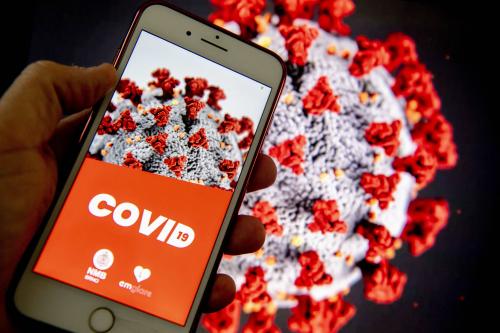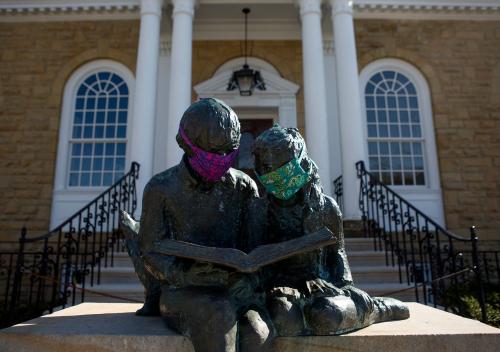When I was a child, doctors giving vaccine shots used to hand out candy or a little toy to take the sting and fear out of the shot. A similar idea could rescue the U.S. economy when one or more COVID vaccines are approved by the FDA and widely available for mass uptake.
Infectious disease experts, such as Minnesota’s Michael Osterholm, tell us that “herd immunity” – or the point at which the virus will quit spreading like wildfire – will be reached when at least 60 percent of the population is immune. A truly effective vaccine – which even those who have survived the virus should take since no one knows now long their antibody immunity will last – will avoid the tragedy of the million-plus deaths it otherwise could take for the country to reach herd immunity.
Provided enough people take the vaccine when they can. Since no vaccine will be perfectly effective – Dr. Fauci has said he could live with a vaccine that was 75 percent effective, which could be optimistic – that means that at least 80 percent of the U.S. population (60 percent divided by 75 percent) must be vaccinated if the virus is to be tamped down to the point where enough people will feel safe to patronize service establishments and travel so the country and the economy can return to some semblance of normal.
But now that seemingly everything about the virus – its severity and whether to wear masks in public, to take two examples – has become deeply politicized, is there any hope of reaching that 80 percent threshold?
Not according to a poll by NPR/PBS/Marist released on August 14, which reported that more than one third – 35 percent to be precise – of Americans won’t take the vaccine when it is available, which means that the population take-up percentage would only be 65 percent, or well short of the 80 percent target. The take-up rates predictably differ by party, with 71 percent of Democrats saying they’ll take the shot versus 48 percent for Republicans.
At this point, it doesn’t appear that Presidential persuasion will change these results materially. Two thought experiments explain why.
Assume first that former Vice President Biden wins in November and takes office after months of President Trump’s discrediting the legitimacy of the election itself. Even if all Biden voters and non-voting sympathizers – say 55 percent of the population – heed his call to take the vaccine, the nation still won’t cross the 80 percent threshold without a majority of Trump’s voters and non-voting sympathizers also doing the same thing. The NPR/PBS/Marist poll suggests that, at least at this point, this outcome is unlikely. Even among Democrats, the intended vaccination percentage in that poll is below 80 percent.
In principle, a President Biden could take executive actions or seek legislation – assuming Democrats control both the House and Senate and the filibuster rule is abandoned – penalizing those who don’t take the shots (for example, by requiring vaccination certificates before entering most public spaces). But imposing any penalties on people who don’t take the vaccine at the outset of his presidency – even if the penalties were both effective and constitutional, which is not at all clear it would be – would aggravate polarization, conceivably cause violence, and prevent any healing of the country that Biden has promised to usher in.
Alternatively, assume that President Trump wins reelection and then urges everyone to take the vaccine. Anti-vaxxers who otherwise support the President are unlikely to follow his advice. Two additional groups of people might not either. One group consists of those who are disposed to take the vaccine, but who will hold back for 6-12 months or longer until they have confidence that it truly is effective and safe. Another group would include many Democrats, who having listened to the President ignore or mock legitimate science during the pandemic, may not trust that the FDA’s approval of any vaccine is truly on the up and up. People in these three groups combined could easily exceed 20 percent of the population, enough to defeat herd immunity.
The “adult” version of the doctor handing out candy to children, fortunately, points toward a solution: pay people who get the shot (or shots, since more than one may be required).
How much? I know of no hard science that can answer that question, but my strong hunch is that anything less than $1,000 per person won’t do the trick. At that level, a family of four would get $4,000 (ideally not subject to income tax) – a lot of money to a lot of families in these difficult times, and thus enough to assure that the country crosses the 80 percent vaccination threshold.
Economists will point out that any vaccine payment scheme will overcompensate, since most of those getting the shots and thus the money will take the vaccine in any event. Others will object that a vaccine payment scheme rewards people for being intransigent, for any number of reasons. Both those objections are valid, but also beside the point.
If the nation doesn’t get to herd immunity once the vaccine becomes widely available and has been independently validated, we’re all out of luck: the economy will continue to struggle with a weight on its chest, and American society won’t get back to normal. Any overpayment is simply part of the price Americans would have to pay, given our deep political divisions, in order get all of our lives back. The alternative – living with the fear of a virus that has not been sufficiently tamped down – is much worse.
Admittedly, the price tag of about $275 billion – $1,000 times 275 million, or about 80 percent of population – at first blush looks high. But the vaccine reward would be a one-time payment. Compare it to the trillions of dollars in financial rescue packages that already have or will be legislated until the virus is brought under the control, as well as the ongoing trillions of dollars in cumulative lost output and incomes the economy will suffer if herd immunity is not reached. By these yardsticks, the $275 billion price tag, even if it is deficit-financed, is a bargain.
What if the $1,000 is not enough, getting us to, say, a take-up rate of 75 percent, but not 80 percent? We could live with that result and hope that enough other people wear masks and social distance in areas where the 80 percent threshold hasn’t been crossed, or ultimately that advances in therapeutics will be sufficient to reduce the mortality rate to or below the level of the seasonal flu, thus removing the fear of catching the virus by venturing outside.
A potentially better idea is to hold back a substantial portion of the $1,000 – say $800 of it – until the 80 percent threshold is reached, ideally on a national basis, since people move around and can thus still spread the infection from the remaining hot spots. Because people who have taken the shot will get the balance, by check or wire, once the national vaccination threshold is crossed, they will have strong incentives to persuade their family members, neighbors, work colleagues, church members, and so on to get the shot so that everyone who does can collect the full $1,000 per person payment.
One thing should be clear the outset: Congress should make clear that the payment will not be increased to get the nation across the finish line – which means it is better to start out high, rather than offering a lower payment and only later increasing it if needed. If the incremental strategy is followed, too many people could hold back, hoping to cash in and get even more if the payment in fact later is increased.
There are three qualifications to these suggestions, which may affect achievement of the herd immunity objective. The first could be good news, the other two less so.
First, the incentive payments are likely to be more effective with lower income people and families than those with higher incomes. Since Black and Latinx populations, on average, have lower incomes, and also have had much worse experience with the virus, greater vaccination rates among these minorities may reduce the required overall participation level to something short of the 80 percent.
Second, the population herd immunity threshold and vaccine effectiveness assumptions used above may be off, but even if that is true, it may not provide much comfort. For example, the herd immunity population threshold could be lower than 60 percent, even as low as 50 percent, as some researchers have speculated, which by itself would reduce the vaccination participation target. But the initially approved vaccines also may be much less effective than the assumed 70-75 percent effectiveness level – say, 50-60 percent. The combination of these two alternative assumptions would require not 80 percent – but closer to 100 percent – of the population to be vaccinated, clearly an impossible goal. Yet even that worst case outcome can be mitigated through continued social distancing and mask wearing, while we wait for even more effective vaccines and therapeutics.
Another caution is that the immunity conferred by any vaccine may be short-lived, requiring repeat booster shots, maybe every year, or even more frequently. In that event, will it require the government to continue to pay people for every repeat shot? My hope, and that is all it is at this point, is that if the initial vaccine reward idea got the country initially to herd immunity, enough people would then have seen the economic benefits of getting to that point that future monetary incentives would not be needed for the repeat shots. But I could be wrong, in which case future reward payments, perhaps of a lesser amount, may be required – again, as the price the country must pay to continue to have a normal economy and society.
The bottom line: It is not too early for policy makers to start thinking about paying for COVID vaccinations. All the discussions about how to prioritize who will be eligible for the vaccine pale next to the importance of getting enough people to take it to get to herd immunity. If we don’t get there, we could face a future of continued economic malaise, at best, or far worse if the pandemic recession/depression drags on until the virus doesn’t.
Robert Litan is a non-resident Senior Fellow in the Economic Studies Program at the Brookings Institution, a program he formerly directed.
The author did not receive financial support from any firm or person for this article or from any firm or person with a financial or political interest in this article. He is not currently an officer, director, or board member of any organization with a financial or political interest in this article.





Commentary
Op-edWant herd immunity? Pay people to take the vaccine
August 18, 2020